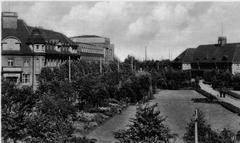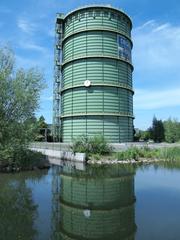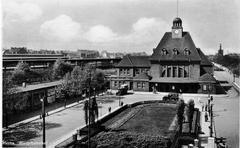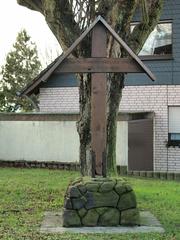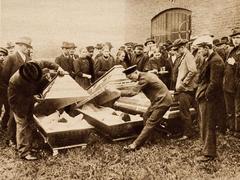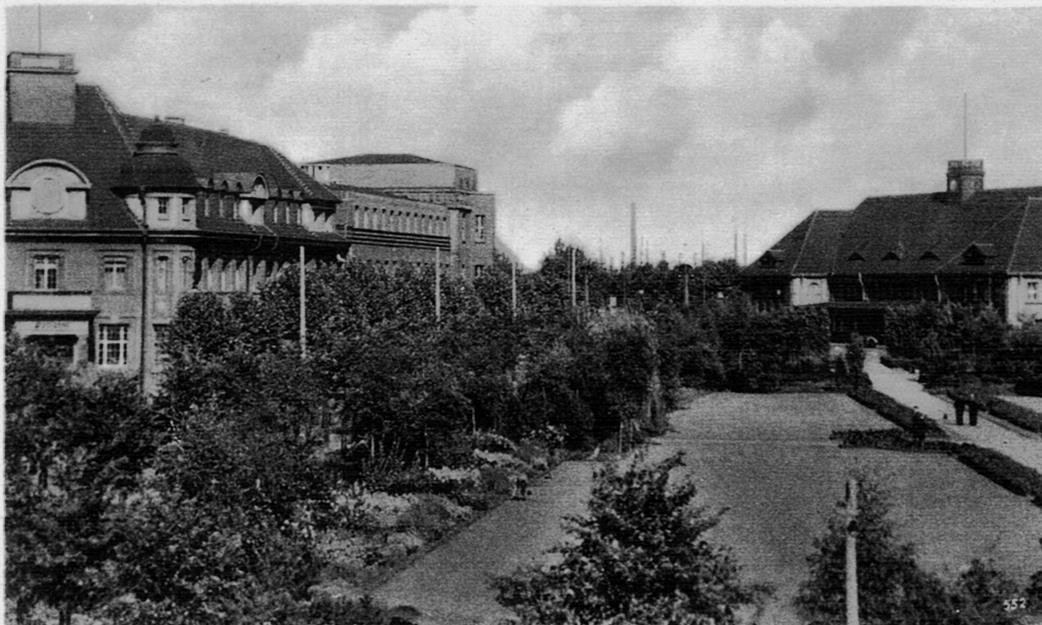
Wanne-Eickel Central Station: Visiting Hours, Tickets, and Travel Guide
Date: 14/06/2025
Introduction: The Role and Significance of Wanne-Eickel Central Station
Wanne-Eickel Central Station (Wanne-Eickel Hauptbahnhof) is a cornerstone of Herne and the Ruhrgebiet’s transport network and a living monument to the region’s industrial legacy. Established in the 19th century to serve the burgeoning coal and steel industries, the station has grown into a modern railway junction that seamlessly connects travelers across Germany while preserving a wealth of architectural and historical character. With its strategic location on major rail corridors, comprehensive accessibility features, and proximity to attractions like the Herne Mining Museum and Cranger Kirmes, Wanne-Eickel Central Station is both a gateway to the Ruhr’s past and an essential node in its present-day mobility (herne-damals-heute.de, rhein-ruhr-metropolregion.reisen-ist-freiheit.com, DB InfraGO AG).
This guide offers detailed information for travelers and history enthusiasts: visiting hours, ticketing, travel tips, accessibility, and how the station anchors the Ruhrgebiet’s transformation—from its industrial zenith to a vibrant cultural region.
Contents
- Historical Overview
- Visitor Information
- Station Layout and Accessibility
- Ticketing and Train Schedules
- Passenger Amenities
- Connectivity and Transport Links
- Safety, Security, and Digital Services
- Nearby Attractions
- FAQ
- Conclusion
- Sources
Historical Overview
From Industrial Roots to Modernization
Wanne-Eickel Central Station’s origins date back to the mid-19th century, when the Cologne-Minden Railway Company extended rail lines through the Emschertal to serve the Ruhrgebiet’s mines and steelworks. Initially a freight depot, the station rapidly grew in importance with the opening of the Pluto-Thies freight yard in 1856 and transformation into a passenger hub by 1864 (herne-damals-heute.de). By the late 19th century, the “Wanne” area had become synonymous with rail transport, handling goods from over 20 mining shafts (de.wikipedia.org).
A major reconstruction in 1913 established the station as one of Germany’s most advanced, with extensive platforms and a freight yard handling hundreds of wagons. It remained a critical logistics hub through wartime, reconstruction, and into the postwar economic boom.
Decline, Renewal, and Cultural Rebirth
With the Ruhr’s coal and steel decline from the 1960s, the station’s prominence waned, but revitalization arrived in the 1990s through the Internationale Bauausstellung (IBA) Emscher Park, which brought a new steel-and-glass façade, modernized platforms, and an integrated bus station (herne.de). Today, it stands at the heart of the Route of Industrial Culture, inviting visitors to explore the Ruhr’s industrial and urban transformation (route-industriekultur.ruhr).
Visitor Information
Visiting Hours
- Station access: Open daily, typically from 4:00 AM to 1:00 AM. Some entrances and facilities follow these hours.
- Ticket counters: Usually open from 6:00 AM to 8:00 PM.
- Self-service ticket machines and station facilities: Accessible 24/7.
Ticketing Options
- Purchase points: Staffed counters, self-service machines, and the Deutsche Bahn website/app.
- Types: Single tickets, day passes, group tickets, and regional VRR network passes (fahrplan.guru).
- Pricing: Varies by destination and ticket type (e.g., a single to Dortmund ~€5; day passes for unlimited local travel).
- Special event tickets: Available during major events such as the Cranger Kirmes.
Accessibility
- Elevators and ramps: Step-free access to all platforms.
- Tactile guidance: For visually impaired passengers.
- Mobility Service Centre: Assistance can be arranged in advance (+49 30 65212888).
- Accessible restrooms: Available throughout the station.
Station Layout and Amenities
Platforms and Facilities
- Platforms: Eight, numbered 3–8, with standard 76 cm heights and lengths between 220–401 meters for easy boarding (DB InfraGO AG).
- Shelters: Weather protection on all platforms.
- Waiting areas: Heated main lounge and open platform seating.
- Restrooms: Accessible, clean, with baby-changing stations.
- Lockers: Self-service luggage lockers for short-term storage.
Shops and Services
- Food and beverage: Bakeries, cafés, snack bars.
- Retail: Newsstands, convenience stores, and travel essentials.
- Wi-Fi and charging: Free Wi-Fi in the concourse and charging stations for mobile devices.
- Lost and found: Operated during business hours.
Connectivity and Transport Links
Rail Services
- Regional-Express (RE), Regionalbahn (RB), Intercity (IC): Frequent connections to Dortmund, Duisburg, Essen, Münster, and more (Wikivoyage).
- S-Bahn Rhein-Ruhr (S2): Direct access to metropolitan destinations.
Bus and Tram
- Bus terminal: Adjacent to the station, with extensive local and regional routes (HCR, BOGESTRA).
- Tram: STRB 306 connects to Bochum and other cities.
Other Mobility Options
- Taxi rank: 24-hour service at the main entrance.
- Bicycle: Secure parking and rentals via Metropolradruhr.
Safety, Security, and Digital Services
- CCTV and security patrols: Ensure passenger safety.
- Emergency call points: Clearly marked throughout the station.
- Cleanliness: Maintained by regular cleaning schedules.
- Digital boards and interactive kiosks: Real-time train information, maps, and tourist details.
Nearby Attractions
- Herne Mining Museum: Ruhr mining history, a short tram ride away.
- Cranger Kirmes: Major annual funfair, easily reached by local transport.
- City parks and historical buildings: Christuskirche, Rathaus Herne, and Stadtgarten Wanne-Eickel (Trip.com).
Practical Tips
- Plan ahead: Check real-time schedules, especially during renovations or events.
- Peak times: Avoid weekday rush hours (7–9 AM and 4–6 PM) for a more relaxed visit.
- Accessibility: Contact the Mobility Service Centre 24 hours in advance if assistance is needed.
- Tickets: Day and group passes offer savings for local exploration.
- Stay informed: Use the Moovit or VRR apps for transport updates (Moovit).
- Language: Basic German can be helpful, but staff and signage accommodate English speakers.
FAQ
Q: What are the visiting hours for Wanne-Eickel Central Station?
A: Daily from around 4:00 AM to 1:00 AM; ticket counters open 6:00 AM–8:00 PM.
Q: How can I buy tickets?
A: At counters, self-service machines, or online via Deutsche Bahn.
Q: Are there accessible features for disabled travelers?
A: Yes, including elevators, tactile paths, and assistance services.
Q: What attractions are nearby?
A: Herne Mining Museum, Cranger Kirmes, and several historical and cultural sites.
Visual Gallery
Ongoing Modernization
As of June 2025, the station is undergoing a €25 million modernization to improve accessibility, comfort, and sustainability. Check for temporary platform changes and updated access routes during your visit (Deutsche Bahn press release).
Conclusion
Wanne-Eickel Central Station is a dynamic portal to Herne and the Ruhrgebiet—blending efficient transport, historical depth, and modern amenities. Its accessibility, extensive connections, and proximity to cultural highlights make it an ideal starting point for both travelers and history lovers. For current updates, ticketing, and travel tips, use digital resources such as Deutsche Bahn’s portal, the Herne tourism website, and the Audiala app.
Sources and Further Reading
- https://herne-damals-heute.de/lokale-helden/wolfgang-berke-texte/wanne-eickel-stadt-der-1-000-zuege/
- https://www.dbinfrago.com/web/bahnhoefe/leistungen/stationsnutzung/stationshalt/stationsausstattung/Wanne-Eickel-Hbf-12672090
- https://rhein-ruhr-metropolregion.reisen-ist-freiheit.com/bahnhof-herne/
- https://route-industriekultur.ruhr/en/
- https://www.deutschebahn.com/de/presse/presse-regional/pr-duesseldorf-de/presseinformationen-regional/Wanne-Eickel-Rundum-Erneuerung-des-Hauptbahnhofs-startet—12907582
- https://www.ruhr24.de/bochum/bochum-hauptbahnhof-hbf-zug-sperrung-regionalexpress-ice-deutsche-bahn-februar-bauarbeiten-april-93507349.html
- https://www.spiegel.de/panorama/gesellschaft/wanne-eickel-kann-sich-eine-ehemalige-zechen-metropole-neu-erfinden-a-37fcfece-4a19-4cd3-897a-4553c081a929
